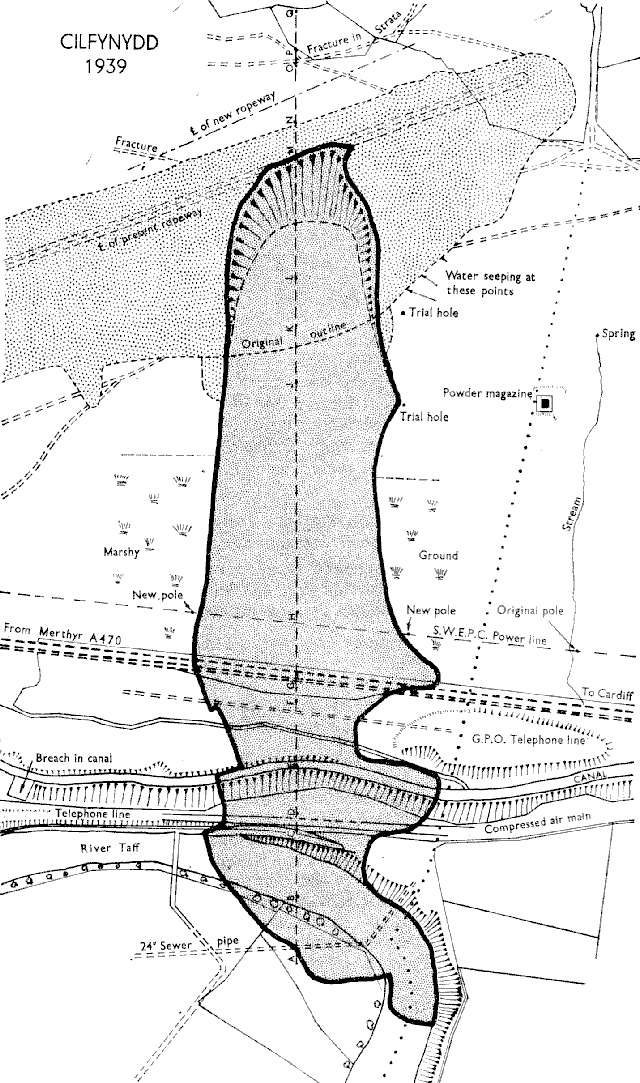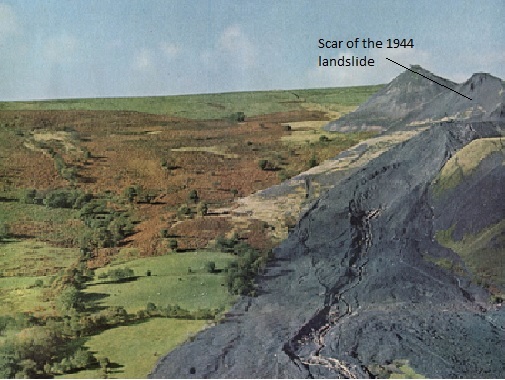18 October 2016
Aberfan: the National Coal Board failures part 1
Posted by Dave Petley
Aberfan: the National Coal Board failures
As I noted in my post yesterday about the Aberfan disaster, the official Tribunal roundly criticised the National Coal Board for the part that they played in the disaster. Indeed, having denied responsibility through much the of the hearing, late in the day the counsel for the Board accepted the blame. As the Tribunal states in its report:
But, as witness followed witness, the answer to the question — Should anyone be blamed for the disaster? — became crystal clear as far as concerned the National Coal Board. It was finally enunciated in this way on Day 74 during the closing speech of counsel for the Board: “Need it have happened? . . . There is a very short answer to that one. It need not have happened and should not have happened if proper site investigations had been carried out beforehand. The failure to have any site investigations beforehand must be attributed to lack of instructions from the Coal Board.”
Before the disaster (and indeed afterwards as well) there were multiple failures by the National Coal Board, but I will focus on two key aspects – the history of spoil heap flowslides in South Wales (which I will describe today) and the failure to understand the site conditions at Aberfan (which will be the subject of my next post).
Previous flowslides in coal spoil heaps
Perhaps the most unbelievable aspect of the Aberfan disaster is the failure of the National Coal Board to recognise that flowslides in spoil heaps represented a serious threat, despite multiple previous examples. The Tibunal report has almost 100 pages describing previous flowslide events, of which a number are very significant:
The 1939 Slide at Cilfynydd
In 1939 a very serious landslide occurred in a spoil heap at the Albion Colliery near to Abercynon, about 8 km from Aberfan. The Tribunal report describes it thus:
At 1:40 p.m. on 5th December, 1939, after a period of heavy rainfall, a large slide of a tip belonging to the Albion Colliery (owned by the Powell Duffryn Company) occurred at Cilfynydd Common, near Abercynon, some five miles from Aberfan. The tip, situated on the hillside adjoining the main Cardiff-Merthyr road, slid some 710 feet [215 metres] to the road, crossed it, and then progressed a further 720 feet [220 metres] to beyond the river bed. The width of the slide below the tip was 400 feet [120 metres], the main road was blocked for 585 feet [180 m] to a depth of 20-25 feet [6-8 metres], the Glamorgan Canal was filled for 540 feet [165 metres] and the railway for 500 feet [150 metres]. The River Taff was blocked to a depth of 15 feet [5 metres] for some 500 feet [150 metres] and substantially diverted. It was estimated that the total weight of the tip material in the slide was some 180,000 tons [163,000 tonnes]. Having regard to the heavy volume of traffic normally passing along this road, it is remarkable that there were no fatalities.
The tribunal provided a diagram showing the dimensions of this landslide:

The 1939 flowsllide at Cilfydnydd, from the official Tribunal report
.
In the aftermath of this landslide, which was clearly a lucky escape, a document was written about the risks of such failures:
Immediately following upon the Cilfynydd slide, in that same month of December, 1939, a Powell Duffryn engineer (thought to be a Mr. A. L. Davies) prepared an illustrated memorandum entitled “The Sliding of Colliery Rubbish Tips”. The Chief Engineer of the Rhymney Valley area of Powell Duffryn handed a copy of this memorandum to his son, Mr. Clifford Jones, who later became the Divisional Mechanical Engineer of the National Coal Board South Western Division. We shall have much to say hereafter about this memorandum, and content ourselves at this stage by saying that it was full of common-sense. Indeed, had its points and warnings been observed, the probability is that there would have been no disaster in 1966. But the memorandum was put into a drawer and forgotten until 1965.
The 1944 flowslide at Aberfan
Tip Number 4 at Aberfan started to be constructed in 1933. on 27th October 1944 a major flowslide occurred in this tip (although the report speculates that their may have been an earlier slide as well). This was a major failure – the spoil travelled about 500 metres. Indeed this slide is depressingly obvious in the images of the Aberfan site after the disaster: This is one of the few colour photographs of the landslide – I have annotated the 1944 landslide scar:-

Colour image of the Aberfan landslide site after the 1966 disaster, showing the location of the 1944 landslide scar
.
As the tribunal noted:
It is difficult to exaggerate the importance of this slide in 1944. To all who had eyes to see, it provided a constant and vivid reminder (if any were needed) that tips built on slopes can and do slip and, having once started, can and do travel long distances. Mr. Geoffrey Morgan, while denying (in common with the vast majority of the witnesses) any appreciation of the possibility that a tip slide could ever reach Aberfan village, conceded that”. . . once a tip of considerable proportions on a mountainside does slip, it is impossible to predict how far it will reach”.
The 1963 landslides in Tip Number 7
The 1966 disaster occurred on Tip Number. Sadly, this spoil heap had failed previously, in 1963, probably more than once. In fact the Tribunal provides little technical detail about this set of landslides, noting with barely contained anger that the National Coal Board had not been very forthcoming about the events. The tribunal quotes Mr. W. R. King, the National Union of Mineworkers’ Lodge secretary:
“What I noticed on the day that I had a look at the tip in November (1963) was as if somebody had scooped the middle of the tip out with a huge shovel and also that the base of the tip had run forward. There was a distinct hole in the centre of the tip, and the top plateau of the tip had sunk a little, and the other feature then was the fact that slurry had run down for a considerable distance. . . . The hole extended up two-thirds of the tip itself . . . from the bottom. The width, as far as I could recall, (was) about 80 to 90 yards.”
Later the report provides a little more detail:
Although on Day 65 Mr. Piggott, the National Coal Board expert, accepted that . . . “there were signs of failure and degrees of failure on the tip from about 1963 onwards”, it was not until the 66th sitting of the Tribunal that the issue of whether or not there had been a slide of Tip 7 late in 1963 was removed from the realm of controversy. This was when Professor Nash, the expert witness called by the National Coal Board, agreed that the relevant aerial photograph established (a) that there had been a rotational slip of the tip which was quite different from a tailings run, (b) that a big volume of material had moved, though it might not have moved very far, and (c) that the result of this movement would inevitably have been observed by any proper investigation of the tip.
The Tribunal notes that the slope showed signs of movement and deformation from then right up until the failure. The Tribunal notes that:
Two convincing witnesses, Mr. D. T. Jones and Mr. M. W. Maybank, testified that they were able to judge by reference to a dead tree (known locally as Hangman’s Tree) on the mountainside that during the last six months before the disaster the toe of Tip 7 advanced downwards by some 20-30 feet. There is credible evidence that in the last three to four months there were frequent sinkings of the top of the tip of up to four feet and that a few times during that period the sinkings were of 10-12 feet. These occurred right across from one side of the tip to the other at the point where a ridge had existed ever since the major slide of 1963.
A failure to learn lessons
It is now clear that, in addition to the failures described in the report, other slips and flowslides occurred in spoil heaps in the South Wales coalfield. The failure to learn lessons from these multiple accidents, and the lack of recognition that spoil heaps were hazardous, is extraordinary, especially as the risks had been documented. In addition, there was an extraordinary local failure to recognise that the tips at Aberfan were particularly problematic.
Despite this, not a single National Coal Board employee was prosecuted, dismissed or even demoted in the aftermath of the accident.


 Dave Petley is the Vice-Chancellor of the University of Hull in the United Kingdom. His blog provides commentary and analysis of landslide events occurring worldwide, including the landslides themselves, latest research, and conferences and meetings.
Dave Petley is the Vice-Chancellor of the University of Hull in the United Kingdom. His blog provides commentary and analysis of landslide events occurring worldwide, including the landslides themselves, latest research, and conferences and meetings.